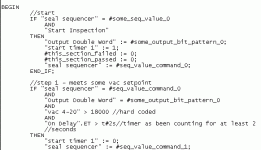Reksio
Member
Hi All,
I need some clarification on sequencers, I researched this forum but haven't been able to find a good explanation, including the ones with examples.
First of all, I'm using them on a Compact logic L45, second I know it is a form of shift register just don't understand the whole mechanism. So I have the SQO instruction (for the sake of example lets do it in binary)
SQO:
Array:01010101
Mask:11111111
Destination:00000000
Control:00000000
Length:1
Position:1
First of all, what is the purpose of: array, mask,destination, control,length, position elements?
This is the way I understand it: array is the one we use in programming - namely during the steps we determine if each bit is activated or not. Mask stays always the same. Destination is the result of each comparison. So what is control? Length is the size of the memory area we want to operate on, step is the offset?
Also how are these instruction different SQI,SQL,SQO?
Please abstain from using poor examples, or opinions.
I need some clarification on sequencers, I researched this forum but haven't been able to find a good explanation, including the ones with examples.
First of all, I'm using them on a Compact logic L45, second I know it is a form of shift register just don't understand the whole mechanism. So I have the SQO instruction (for the sake of example lets do it in binary)
SQO:
Array:01010101
Mask:11111111
Destination:00000000
Control:00000000
Length:1
Position:1
First of all, what is the purpose of: array, mask,destination, control,length, position elements?
This is the way I understand it: array is the one we use in programming - namely during the steps we determine if each bit is activated or not. Mask stays always the same. Destination is the result of each comparison. So what is control? Length is the size of the memory area we want to operate on, step is the offset?
Also how are these instruction different SQI,SQL,SQO?
Please abstain from using poor examples, or opinions.




